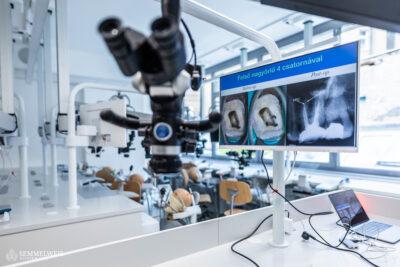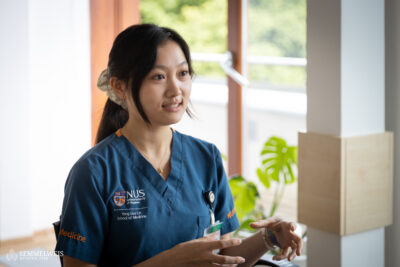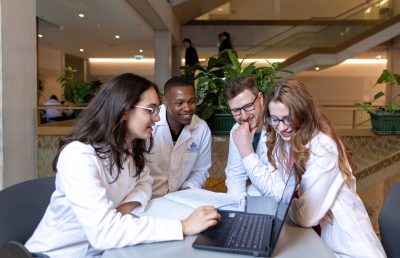On 12 March, a Japanese professor from the Tochigi campus of the International University of Health and Welfare (IUHW) gave an online lecture to the medical students of the Semmelweis University in surgery. Professor Masashi Yoshida is a world-renowned surgeon and researcher, board member of several Japanese and international societies, secretary of the Hungarian-Japanese-Polish Surgical Society, and visiting professor at Semmelweis University since 2015. Dr. József Sándor, Professor Emeritus at the Department of Surgical Research and Techniques, welcomed the Japanese lecturer in the Nagyvárad Square Theoretical Block (NET), who titled his lecture as follows: Acute and elective surgical procedures. Preoperative preparation of patients. Surgical penetrations.
In his foreword, Masashi Yoshida thanked the audience for the invitation, welcomed the leaders of the department, and then surprised the audience by giving the floor to the fourth-year medical students of his own university, who gave a presentation on the Japanese medical university network and curriculum.
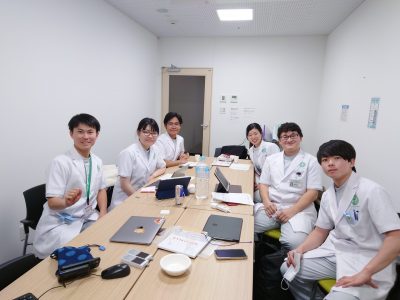 According to their admission requirements, medical students should not only serve medicine and science with their knowledge, but also contribute to the development of a healthy society. Hungarian students also got to know the weekly schedule and daily routine of Japanese doctors, their sport and cultural activities.
According to their admission requirements, medical students should not only serve medicine and science with their knowledge, but also contribute to the development of a healthy society. Hungarian students also got to know the weekly schedule and daily routine of Japanese doctors, their sport and cultural activities.
In his introduction, Masahi Yoshida recalled the founding of the Japanese-Hungarian Surgery Society 28 years ago in 1996, and the society’s biannual symposia for young surgeons and researchers, which allowed him to get to know Hungarian surgeons and Semmelweis University, where his son studied and graduated in medicine years ago.
He illustrated the possibilities of surgical interventions and the patient care pathway by describing an imaginary patient with abdominal pain in a serious condition arriving at a hospital in the middle of the night and being admitted to the intensive care unit. There, he is examined step by step, it is determined whether the condition is indeed a surgical one, whether urgent surgery is needed or it may be postponed. Nevertheless, a detailed medical history and a careful physical examination precede any other procedure.
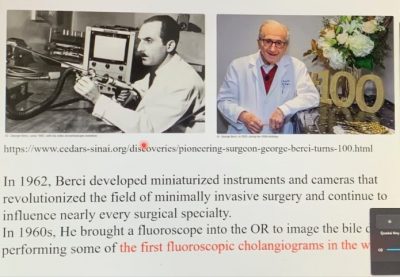 With the help of video clips, Professor Yoshida explained the directions, methods, advantages and possible disadvantages of surgical penetrations. He then presented an area of his own research, the application of fuorescence guided surgery. This revolutionary new technique can visualize blood supply to an area and also the bile ducts, allowing surgery to be performed in safer conditions. In his lecture, the professor emphasized that much of his research in this area was carried out at the George Berci Surgical Training and Research Laboratory at Semmelweis University in Herceghalom, in collaboration with colleagues from the department. He also commemorated the eponym of the laboratory, George Berci, the pioneer of minimally invasive surgery, who is celebrating his 100th birthday these days, a Hungarian surgeon celebrated worldwide, who is Professor Honoris Causa at Semmelweis University.
With the help of video clips, Professor Yoshida explained the directions, methods, advantages and possible disadvantages of surgical penetrations. He then presented an area of his own research, the application of fuorescence guided surgery. This revolutionary new technique can visualize blood supply to an area and also the bile ducts, allowing surgery to be performed in safer conditions. In his lecture, the professor emphasized that much of his research in this area was carried out at the George Berci Surgical Training and Research Laboratory at Semmelweis University in Herceghalom, in collaboration with colleagues from the department. He also commemorated the eponym of the laboratory, George Berci, the pioneer of minimally invasive surgery, who is celebrating his 100th birthday these days, a Hungarian surgeon celebrated worldwide, who is Professor Honoris Causa at Semmelweis University.
Masashi Yoshida concluded by showing, through diagrams, how we can collectively contribute to a higher level transformation of medicine in the future.
By working together and collaborating, Semmelweis University and IUHW physicians can do a lot for the development of human medicine even after graduation
– he emphasized.
The Japanese professor’s lecture for Hungarian medical professionals was not only an introduction to the given topic. He proved that a practicing surgeon can carry out effective research in addition to his daily work. This duality in his dedication to his profession also sets an example for future generations.
Photo and text: Dr. József Sándor
Translation: Viktória Kiss
